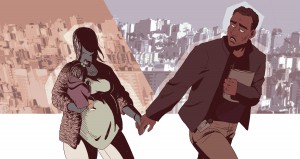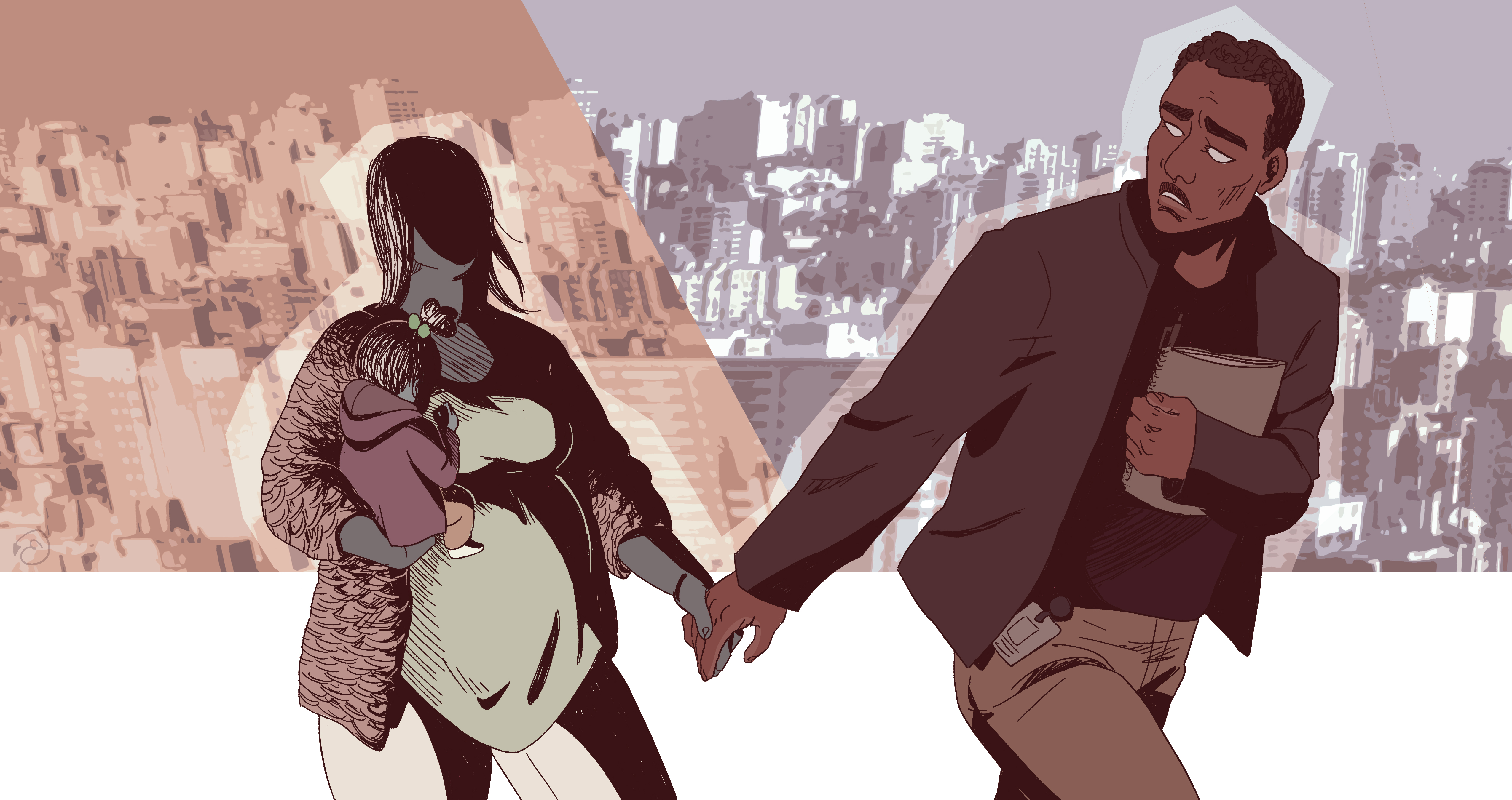An essay by Specialist Estaugh Johnten, as provided by Mickey Hunt
Art by Errow Collins
A frozen image of the park’s playfield looks somewhat like an ordinary playfield on Earth. Families are sitting on blankets with their picnics, a canine is poised in the air as he clamps his teeth on a flying disk, a woman is jogging down the path between a row of shade trees. Children dash though a play castle with its hanging bridges and polymer towers. All this would look ordinary, except the colors in the image are antipodal like in an old-fashion film negative. What might be shadow emanates light, and it all incandesces with a lustrous glow.
An expectant crowd has gathered at the edge of a field, and upon closer inspection, you’d see that the postures and faces droop with sadness. They’re faces possessing delicate contours no race of Earth ever had.
Even stranger would be watching the film in forward motion, because everything moves backwards: the people, the leaves on the trees, even the sounds of voices.
I myself am walking backwards, with my arm around the waist of a wife I’ve never met, and a charming child of mine with her arm wrapped around my neck. My wife is carrying my field notebook. I’m elated, and of course completely bewildered. As we walk in reverse toward the waiting crowd, I nearly stumble, because I can’t see where we’re going.
Children are playing a game nearby. One girl runs backwards and stoops to leave a small white ball on the ground. As we pass, the ball springs up of its own accord and smacks me in the nose. It hurts …
Welcome to the planet Lumen.
The above scenario describes my personal first minutes after I stepped to the ground of a planet circling the first dark star we’ve ever discovered and located within a vast region of dark matter. It’s a planet, indeed a whole region of space, where physics on its most rudimentary level, and, perhaps even time itself, moves opposite to ours.
Earth Command had engaged me on this exploratory mission for the remote possibility of encountering sentient beings on other worlds. While I have studied astrophysics as a hobby, my true expertise was in anthropology. My job was to catalog and analyze sentient alien cultural practices. Little did anyone guess that I would arrive on this new planet already “knowing” a great deal about life there. It was a knowledge that sprang into existence as events occurred. Of all our team members on the mission, I was the only one who could fully wrap his brain around how things worked. My Earth-based supervisors believe it was my Asperger’s Syndrome that enabled me to adapt to the confusing environment. What had isolated me from other people in normal time allowed me to better fit in on Lumen. Plus, I had already developed attitudes and techniques to help me compensate for my misperceptions.

I finished writing and held up the notebook so she could read my words, I love you and our baby very, very much. I promise, we will be together again.
To read the rest of this story, check out the Mad Scientist Journal: Autumn 2016 collection.
Estaugh A. Johnten grew up on a farm in Pennsylvania and earned a B.A. in Social/Cultural Anthropology at Templetown University. He received a Fulhaus/DAD Fellowship for the Eberhard-Hostleter-Universität in Tübingen, Germany, where he subsequently completed a M.A. His work with the extraordinary voyage of the USS Radiant was funded through a grant from the International Academies of Sciences, Medicine, and Engineering. When defending his Ph.D. dissertation at Hahvad University just prior to his departure from regular time, he told the examination committee to “Jump in the lake.”
Mickey Hunt explores the universe from his base in Asheville, North Carolina. His reports disguised as fiction have appeared in the Literary Hatchet, AntipodeanSF, the Dead Mule School of Southern Literature, the Dark Mountain anthology, and elsewhere. Readers may learn more at chaoticterrainpress.blogspot.com.
Errow is a comic artist and illustrator focused on narrative work themed around worlds not quite like our own. She spends her time working with her partner on The Kinsey House webcomic and developing other comic projects when she’s not playing tag with her bear of a cat. More of her work can be found at errowcollins.wix.com/portfolio.
A brief, flash-length version of this story originally appeared in Penumbra, November 2014, with a title of “Not the Wrong Planet.”
“Ships Passing in the Night: Romance & Marriage between Lovers from Anti-synchronous Worlds” is © 2014 Mickey Hunt
Art accompanying story is © 2016 Errow Collins

Notes: The real life story of Estaugh Johnten and Ahtebazille was Henry Wadsworth Longfellow’s inspiration for a portion of his expansive poem, “Tales of a Wayside Inn,” in particular, the happy love story entitled “Elizabeth,” and this explains the poem’s well known, incongruously melancholy words,
“Ships that pass in the night, and speak each other in passing,
Only a signal shown and a distant voice in the darkness;
So, on the ocean of life we pass and speak one another,
Only a look and a voice, then darkness again and a silence.”
“Elizabeth” is an approximation of what the name “Ahtebazille” would sound like in a recording played backwards. Longfellow named the romantic interest male of this section of his poem, “John Estaugh.”